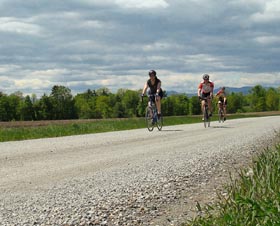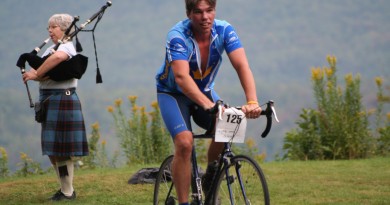Denizens of the Dirt: Cyclocross Bikes Move into Roadie Territory
Posted September 28th, 2009

At the beginning of a group ride early this summer, I looked around and realized I was the only one there with a pure road bike. The change seemed to happen overnight; all of a sudden my skinny tires and fancy wheels were passé. It was as if everyone else had adapted to a new environment, and I was left flopping along the ground, using my fins as feet. I was a roadie in a land of cyclocrossers.
It turns out this new environment I had unconsciously entered was all about dirt roads. After riding the same asphalt loops for years, our group had started branching out on the many unpaved roads that crisscross our corner of Windsor County. But we weren’t just tired of the monotony. We were tired of being heckled, honked, and cursed at by motorists who were frustrated because they needed to slow down as they passed eight or ten cyclists. After a while, these incidents caused us to ride single file at all times, even though the law allows us to ride two abreast, and the rides became less social and more serious, all of us keeping our heads down and our elbows out of the ruthlessly traveled lane. Dirt roads offered a respite from this, and the scenery—dairy farms, mountain vistas, and big, old maple trees—was an aesthetic bonus. Soon we found ourselves playing in the dirt on 80 percent of our rides, and adopting the philosophy of Eric Krivitsky, the custom frame builder at Brownsville’s Penguin Cycles: “It’s not a good Vermont road ride without a dirt road.”
As often happens, our solution created a new problem: road bikes aren’t particularly well suited to the steep and sometimes rough dirt roads, which make up two-thirds of all public roads in Vermont. We needed something capable of maintaining a good pace on paved roads, but also sturdy and stable enough to handle the sharp stones and washboards on the country byways. According to Rob Westover, a sales associate at the West Hill Shop in Putney, a cyclocross bike offers the perfect blend of attributes. “If you get a really nice ’cross bike,” he says, “you can do both: ride aggressively on the dirt, then switch the wheels and have a nearly race-worthy road bike.”
From a distance, a cyclocross bike looks a lot like a road bike. It uses the same size wheels—700c—and has drop handlebars. Zoom in closer and the differences come into focus. The frame has more clearance under the fork and by the bottom bracket, so it can accommodate wider tires. The brakes are cantilevered, like those on an ‘80s-vintage mountain bike, which also affords more clearance, both for tires and mud. This is perhaps the most important distinction. With the extra clearance you can use knobby tires that grip well in mud and snow, or wider road tires, which are more puncture resistant than their skinnier brethren.
And that’s not all. The geometry—the angles of the fork, down-tube and seat-stays—is “more laid back, with less twitchiness,” says Westover. The gearing is a little different, too. A standard road bike has a front crank with 53 teeth on the big ring and 39 teeth on the smaller one. A ’cross bike is usually equipped with a 48/34 crank, which makes climbing steeper grades a bit easier. Though you lose the ability to pedal at high speeds, it’s usually only an issue, says Westover, when you’re going down a long hill or riding on flats in a peloton with a tailwind.
The exact origins of cyclocross bikes are still disputed, but everyone seems to agree that the sport began in the early 1900s as a way for road racers to stay in shape during the winter. They’d race each other from one town to the next, crossing fields and stone walls along the way, sort of like a wheeled version of the steeplechase. The high intensity efforts kept them warm, and hopping off the bike to run for a few dozen yards prevented their toes from freezing. 1902 saw the first cyclocross races, in France. The sport went international in 1923, and today it’s a popular fall sport all over Europe and in pockets of the United States, such as the Northeast, the Pacific Northwest, and Colorado. The modern cyclocross race is usually 45 minutes to an hour in length, and held on a short course with pavement, grass, sand, and dirt. Riders dismount their bikes a few times every lap and jump over wooden barriers or run up small hills, then get back on their bikes and keep going. To see a professional cyclocross racer transition from his bike to his feet at 20 miles per hour is a thing of beauty.
It’s no wonder the bike that evolved for the cyclocross race is also good for riding dirt roads, and people around the state have been catching on. “We’re getting a lot more people coming in and asking for them,” Westover says. Prices for cyclocross bikes start in the same vicinity as those for road bikes, at about $900 to $1,000. To get one as light as a good road bike, you’ll need to spend $2,000 or more.
Fans of cyclocross bikes sing their praises for a variety of reasons. Jan Dembinski, of Woodstock, purchased a ’cross bike this year to take some stress off his nice road bike. Kevin Calder lives on a steep dirt road in Bridgewater, and he bought a ’cross bike so he wouldn’t have an excuse not to ride in bad weather or if the road got muddy. Theo Padnos, a nomad who’s sometimes based in Woodstock, prefers to take his ’cross bike on trips to the Middle East, because it stands a better chance of surviving the pocked roads and wild drivers there. Bike tourers and commuters have been riding ‘cross bikes for years, since they’re often more comfortable than road bikes, and you can easily mount fenders and panniers on them.
As for me? I’ve got a beater ’cross bike I use for winter and spring rides, but I’m saving my pennies for one fast enough to ride all summer, too.

